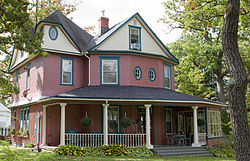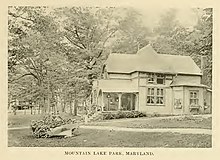Town in Maryland, United States
| Mountain Lake Park, Maryland | |
|---|---|
| Town | |
 Creedmore Creedmore | |
 Location of Mountain Lake Park, Maryland Location of Mountain Lake Park, Maryland | |
| Coordinates: 39°24′06″N 79°22′34″W / 39.40167°N 79.37611°W / 39.40167; -79.37611 | |
| Country | |
| State | |
| County | |
| Incorporated | 1931 |
| Area | |
| • Total | 1.99 sq mi (5.14 km) |
| • Land | 1.92 sq mi (4.96 km) |
| • Water | 0.07 sq mi (0.18 km) |
| Elevation | 2,510 ft (770 m) |
| Population | |
| • Total | 2,147 |
| • Density | 1,121.15/sq mi (432.99/km) |
| Time zone | UTC-5 (Eastern (EST)) |
| • Summer (DST) | UTC-4 (EDT) |
| ZIP code | 21550 |
| Area code(s) | 301, 240 |
| FIPS code | 24-53800 |
| GNIS feature ID | 2391319 |
| Website | Mountain Lake Park |
Mountain Lake Park is a town in Garrett County, Maryland, United States. The population was 2,147 as of the 2020 census.
History

Mountain Lake Park Historic District was listed on the National Register of Historic Places in 1983. Creedmore was listed in 1984.
Mountain Lake Park was founded in 1881 as Maryland's original Chautauqua resort community along the B&O Railroad. Called the Mountain Chautauqua, the summer destination grew to be one of the nation's top destinations over the course of three decades, attracting notable speakers like President William Howard Taft and William Jenning's Bryan. President Benjamin Harrison made a reception stop after getting elected in 1889. The Railroad Evangelist, Jennie Smith, was a frequent speaker and resident of Mountain Lake Park, where she owned and operated the Grace Hotel. Before becoming internationally known as Carter the Great, the young magician was billed under his given name, Charles Carter.
Over 60 original buildings from the turn of the last century remain in Mountain Lake Park. Cottages and boarding homes were indicative of the community's early years. Due to the variety of rural resort architectural styles, the National Register of Historic Places recognized the district. Many buildings feature porches adorned with scroll-sawn balustrades, cornices, and brackets used in fanciful ways. The original Ticket Office that accompanied the 5,000-seat Bashford Amphitheater was refurbished in 2002 and now serves as the town's museum with an extensive display showcasing the town's history. The Amphitheater was razed in the 1940s with the salvaged lumber used to build a number of homes.
After visiting Chautauqua, New York, seven businessmen and ministers fashioned Mountain Lake Park after the New York model with Christian restrictions attached to each deed. They negotiated to add a depot with B&O Railroad President John Work Garrett, after which the county is named. Among the founders was John Franklin Goucher, who helped found the college in Baltimore that bears his name. Goucher served as the last interim president of the Mountain Lake Park Association before it was sold to the Board of Foreign Missions. The town became incorporated in 1931 and is primarily a residential community.
The original clay tennis courts, which the Women's Civic Club began, have been maintained and are used today.
Geography
According to the United States Census Bureau, the town has a total area of 2.01 square miles (5.21 km), of which 1.94 square miles (5.02 km) is land and 0.07 square miles (0.18 km) is water.
Demographics
| Census | Pop. | Note | %± |
|---|---|---|---|
| 1900 | 260 | — | |
| 1910 | 335 | 28.8% | |
| 1920 | 231 | −31.0% | |
| 1930 | 322 | 39.4% | |
| 1940 | 551 | 71.1% | |
| 1950 | 891 | 61.7% | |
| 1960 | 975 | 9.4% | |
| 1970 | 1,263 | 29.5% | |
| 1980 | 1,670 | 32.2% | |
| 1990 | 1,938 | 16.0% | |
| 2000 | 2,248 | 16.0% | |
| 2010 | 2,092 | −6.9% | |
| 2020 | 2,147 | 2.6% | |
| U.S. Decennial Census | |||
2010 census
As of the census of 2010, there were 2,092 people, 873 households, and 531 families living in the town. The population density was 1,078.4 inhabitants per square mile (416.4/km). There were 954 housing units at an average density of 491.8 per square mile (189.9/km). The racial makeup of the town was 97.8% White, 0.4% African American, 0.1% Native American, 0.3% Asian, and 1.3% from two or more races. Hispanic or Latino of any race were 0.6% of the population.
There were 873 households, of which 30.0% had children under the age of 18 living with them, 43.3% were married couples living together, 14.0% had a female householder with no husband present, 3.6% had a male householder with no wife present, and 39.2% were non-families. 32.4% of all households were made up of individuals, and 15.4% had someone living alone who was 65 years of age or older. The average household size was 2.27 and the average family size was 2.86.
The median age in the town was 44.4 years. 22.1% of residents were under the age of 18; 7.3% were between the ages of 18 and 24; 21.4% were from 25 to 44; 29.2% were from 45 to 64; and 20.1% were 65 years of age or older. The gender makeup of the town was 44.9% male and 55.1% female.
2000 census
As of the census of 2000, there were 2,248 people, 867 households, and 578 families living in the town. The population density was 1,485.3 inhabitants per square mile (573.5/km). There were 948 housing units at an average density of 626.4 per square mile (241.9/km). The racial makeup of the town was 99.20% White, 0.36% African American, 0.09% Native American, 0.04% Asian, 0.13% Pacific Islander, and 0.18% from two or more races. Hispanic or Latino of any race were 0.76% of the population.
There were 867 households, out of which 35.4% had children under the age of 18 living with them, 49.5% were married couples living together, 14.1% had a female householder with no husband present, and 33.3% were non-families. 30.0% of all households were made up of individuals, and 12.8% had someone living alone who was 65 years of age or older. The average household size was 2.45 and the average family size was 3.02.
In the town, the population was spread out, with 27.4% under the age of 18, 8.1% from 18 to 24, 25.1% from 25 to 44, 20.5% from 45 to 64, and 19.0% who were 65 years of age or older. The median age was 39 years. For every 100 females, there were 85.5 males. For every 100 females age 18 and over, there were 79.3 males.
The median income for a household in the town was $27,917, and the median income for a family was $37,105. Males had a median income of $29,219 versus $23,348 for females. The per capita income for the town was $14,589. About 16.2% of families and 17.9% of the population were below the poverty line, including 17.2% of those under age 18 and 15.2% of those age 65 or over.
Government
Donald W. Sincell is the current mayor of Mountain Lake Park. Sincell was appointed to the position by the town council on July 13, 2017, to replace former mayor Leo Martin, who died June 25, 2017, but was re-elected posthumously on July 11, 2017.
Transportation

The main method of travel to and from Mountain Lake Park is by road. Several state-maintained highways serve the town, the most prominent of these being U.S. Route 219. US 219 brushes the western edge of Mountain Lake Park on Garrett Highway on its north–south journey across the region. To the south, US 219 connects to U.S. Route 50 before entering West Virginia. Heading north, US 219 passes through the towns of Oakland, Accident and Grantsville while having junctions with Maryland Route 39, Maryland Route 42, U.S. Route 40 and Interstate 68 before heading into Pennsylvania. Maryland Route 135 and Maryland Route 560 also serve Mountain Lake Park, with MD 135 providing connections eastward towards Deer Park and Luke, while MD 560 heads south through Loch Lynn Heights to Gorman.
References
- "Mountain Lake Park". Maryland Manual. Retrieved June 24, 2017.
- "2020 U.S. Gazetteer Files". United States Census Bureau. Retrieved April 26, 2022.
- ^ U.S. Geological Survey Geographic Names Information System: Mountain Lake Park, Maryland
- ^ "National Register Information System". National Register of Historic Places. National Park Service. April 15, 2008.
- "US Gazetteer files 2010". United States Census Bureau. Archived from the original on January 25, 2012. Retrieved January 25, 2013.
- "Census of Population and Housing". Census.gov. Retrieved June 4, 2015.
- "U.S. Census website". United States Census Bureau. Retrieved January 25, 2013.
- "U.S. Census website". United States Census Bureau. Retrieved January 31, 2008.
- "Mountain Lake Park, Garrett County, Maryland". msa.maryland.gov. Retrieved January 4, 2018.
External links
| Municipalities and communities of Garrett County, Maryland, United States | ||
|---|---|---|
| County seat: Oakland | ||
| Towns |  | |
| CDPs | ||
| Unincorporated communities | ||
| Ghost town | ||
| Footnotes | ‡This populated place also has portions in an adjacent county or counties | |